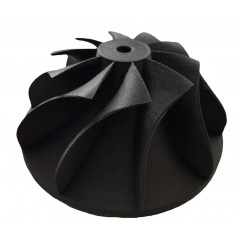Package contains: 1 x CARBONX PA6+CF GEN 3 [CARBON FIBER NYLON] - Black / 1.75mm / 500g - 3DXTech
The CarbonX Gen 3 filament? PA6+CF filament is formulated using a PA6 copolymer reinforced with high modulus carbon fiber. This filament is ideal for anyone who wants a structural component with high modulus, improved chemical and thermal resistance, excellent surface quality, and ease of printing. Gen3 has a higher HDT than previous grades (147°C at .45 MPa) allowing for extended use in higher temperature applications.
The unprecedented stiffness gives designers the properties they need to make their 3D printed parts with less material and save weight without sacrificing stiffness.
Advantages of PA6+CF nylon:
Excellent printability
High tensile strength and stiffness
Abrasion and wear resistance
Better chemical resistance than traditional 3D printing materials
High thermal properties
Filament specifications:
Diameter: 1.75 mm (+/- 0.05 mm)
Recommended print settings:
Extruder: 240-270°C
Platen temperature: 80-110°C
Nozzle: we currently recommend a hardened steel nozzle with a minimum diameter of 0.4 mm
Other: the ideal layer height is 60% of the nozzle diameter. It is not recommended to print layers lower than 0.2 mm with carbon fiber reinforced filaments.
Surface Preparation: We recommend the use of an adhesive
Heated Chamber: Not necessary, but a heated chamber between 30-80°C allows for top layer adhesion and mechanical properties
Media: Water soluble AquaTek X1 USM works great for complex parts.
Drying instructions: 90°C for 4 hours.
Abrasive Material
This material is particularly abrasive among 3D printing filaments. Users may find that standard brass nozzles are chewed up very quickly compared to standard wear. If worn, the nozzle diameter will expand inconsistently and the printer will encounter extrusion problems.
For this reason, we strongly recommend printing this material through a hardened steel nozzle rather than a softer metal. Hardened steel nozzles can often be inexpensive and easy to install depending on the printer manufacturer's instructions.






![CARBONX PA6+CF GEN 3 [CARBON FIBER NYLON] - Black / 1.75mm / 500g - 3DXTech Carbon 3DXTech 19210041 3DXTech CARBONX PA6+CF GEN 3 [CARBON FIBER NYLON] - Black / 1.75mm / 500g - 3DXTech Carbon 3DXTech 19210041 3DXTech](https://www.dhm-online.com/4900128-home_default/carbonx-pa6-cf-gen-3-carbon-fiber-nylon-black-175mm-500g-3dxtech.jpg)
![CARBONX PA6+CF GEN 3 [CARBON FIBER NYLON] - Black / 1.75mm / 500g - 3DXTech Carbon 3DXTech 19210041 3DXTech CARBONX PA6+CF GEN 3 [CARBON FIBER NYLON] - Black / 1.75mm / 500g - 3DXTech Carbon 3DXTech 19210041 3DXTech](https://www.dhm-online.com/4900128-large_default/carbonx-pa6-cf-gen-3-carbon-fiber-nylon-black-175mm-500g-3dxtech.jpg)


![CARBONX CF PEKK-A [AEROSPACE] - Black / 1.75mm - 3DXTech 500g Carbon 3DXTech 19210035 3DXTech](www.dhm-online.com/4900124-home_default/carbonx-cf-pekk-a-aerospace-black-175mm-3dxtech-500g.jpg)




![CARBONX PA12+CF [CARBON FIBER NYLON] - Black / 1.75mm / 500g - 3DXTech Carbon 3DXTech 19210040 3DXTech](www.dhm-online.com/4900127-home_default/carbonx-pa12-cf-carbon-fiber-nylon-black-175mm-500g-3dxtech.jpg)



